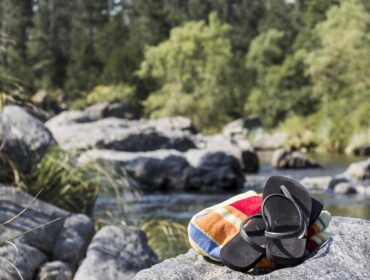The holiday season is a time of giving, travel, and outdoor fun — but they can also bring excess waste, fast buying, and forgotten gear. Before the shopping season kicks in, consider making a few smart, eco-friendly swaps. By choosing gear that lasts longer, packs lighter, and treads softer on the planet, you can enjoy the holiday season with a cleaner conscience and a greener footprint.
1. Upgrade to Reusable Over Disposable
From road trips to winter hikes, single-use items sneak into our routines — plastic bottles, utensils, and snack bags. Swap them for durable, reusable options:
-
Reusable water bottles: Stainless steel or BPA-free bottles like Hydro Flask or Nalgene cut plastic waste.
-
Food containers and wraps: Beeswax wraps and silicone pouches replace plastic bags for snacks and leftovers.
-
Coffee gear: A collapsible cup or travel mug keeps you fueled on the go without disposable waste.
Each small swap adds up, especially when multiplied by every outing and adventure.
2. Choose Sustainable Fabrics
Outdoor apparel has come a long way — many brands now use recycled or natural materials. Before buying new winter wear, check for eco-friendly labels like bluesign®, Fair Trade Certified™, or Global Recycled Standard (GRS).
-
Base layers: Look for merino wool or bamboo for warmth and breathability.
-
Outerwear: Choose jackets insulated with recycled down or synthetic fill made from plastic bottles.
-
Accessories: Opt for gloves, hats, and scarves made from organic cotton or reclaimed materials.
These fabrics not only reduce waste but often last longer — saving money in the long run.
3. Repair and Reuse Instead of Replacing
Before buying new gear, take stock of what you already have. A quick repair can breathe new life into old favorites.
-
Patch torn jackets with gear tape or repair kits.
-
Re-waterproof rain gear with eco-safe DWR sprays.
-
Get boots resoled instead of buying new ones.
Many outdoor brands — like Patagonia and REI — now offer repair programs to extend the life of your gear. Fixing what you own is one of the simplest and most sustainable actions you can take.
4. Trade, Donate, or Buy Used
Holiday shopping often brings an urge to upgrade, but new doesn’t always mean better. Pre-owned gear platforms and local swap events help reduce waste while saving money.
-
Online resellers like Geartrade or REI Used stock quality secondhand gear.
-
Local gear swaps or thrift shops often carry lightly used equipment.
-
Donate old items like jackets, tents, and sleeping bags to community shelters or outdoor youth programs.
By passing along what you no longer use, you’re helping others and keeping usable gear out of landfills.
5. Pick Eco-Friendly Gifts and Packaging
If you’re giving outdoor gear this season, choose items made from recycled or upcycled materials. Go for practical, low-impact gifts like solar lanterns, biodegradable soap, or reusable utensil sets.
Skip shiny wrapping paper — use kraft paper, fabric wraps, or even maps and old trail guides for a personal touch. It’s creative, recyclable, and far kinder to the planet.
6. Think Long-Term: Invest in Quality
The best eco-friendly choice is gear that doesn’t need replacing. Invest in high-quality items that can withstand years of use. A well-made jacket or pack may cost more upfront, but it saves materials, energy, and money over time.
When shopping, ask yourself: “Will I use this often? Can I repair it? Will it last five years?” If the answer is yes, it’s likely a sustainable buy.
7. Reevaluate Your Gear Habits
The holiday season is the perfect time to reset how you think about gear. Instead of collecting more, focus on curating what you already own. Borrow rarely used equipment from friends, rent for specific trips, or share tools within your hiking or camping community. Less gear clutter often means more time and space for adventure.
A Greener Way to Gear Up
Making eco-friendly swaps before the holidays isn’t about perfection — it’s about small, meaningful shifts. Every reusable bottle, every repaired jacket, and every conscious purchase helps cut down waste and carbon impact.
As you prepare for travel, gifting, or winter outings, remember: the most sustainable gear is the one you use often and care for well. Go into the season lighter — on your pack and on the planet.
FAQs: Holiday Season
Why should I switch to eco-friendly gear before the holidays?
Making eco-friendly swaps before the holiday season helps reduce waste, save resources, and support brands that prioritize sustainability. It’s also a great way to prepare for holiday adventures or gift-giving without contributing to overconsumption.
What are the easiest eco-friendly swaps to start with?
Begin with everyday items — reusable water bottles, stainless steel straws, beeswax wraps, and recycled-fabric bags. These swaps are simple, affordable, and make an immediate impact.
Are eco-friendly products more expensive?
Some sustainable products cost more upfront, but they often last much longer. Think of them as long-term investments — a durable jacket or bottle that lasts five years is more cost-effective (and greener) than replacing cheaper items every season.
What should I do with old or unused gear?
Donate usable items to local shelters, outdoor youth programs, or community gear libraries. If an item is beyond repair, look for recycling options — many outdoor brands and retailers now offer gear recycling drop-offs.
How can I make my outdoor gear last longer?
Regular maintenance is key: clean your gear after each trip, store it properly, and reapply waterproof coatings when needed. Patching small tears or replacing zippers extends lifespan and keeps gear out of landfills.
What are some sustainable gift ideas for outdoor lovers?
Consider reusable coffee cups, solar-powered lanterns, biodegradable toiletries, or clothing made from recycled materials. Gifts that promote reuse or adventure — rather than clutter — are both practical and eco-conscious.





